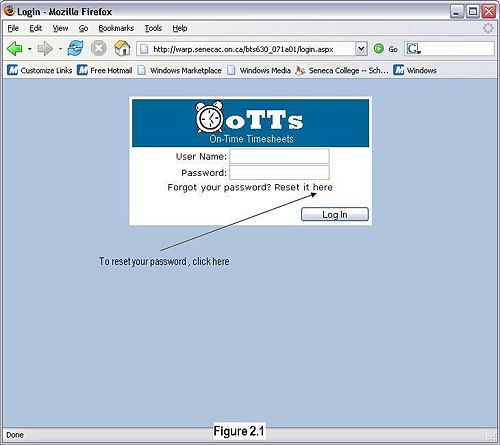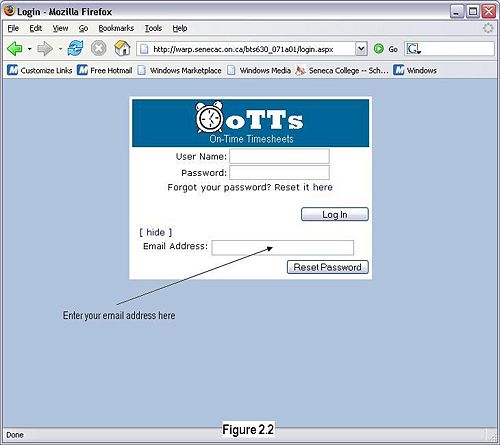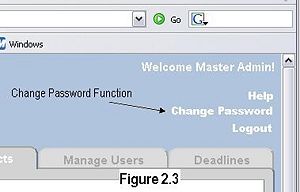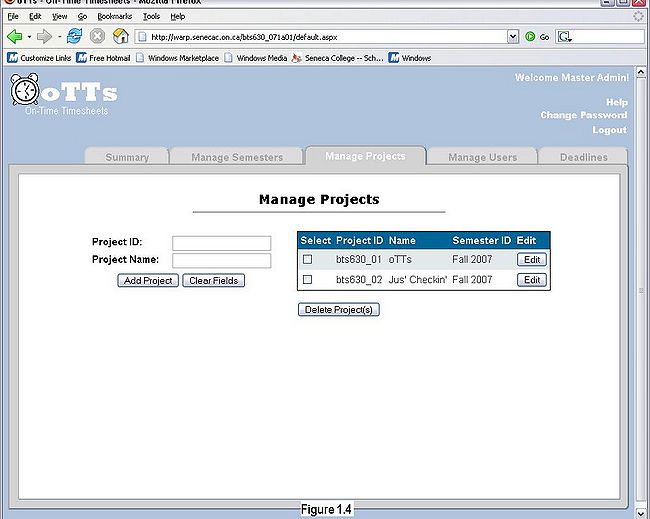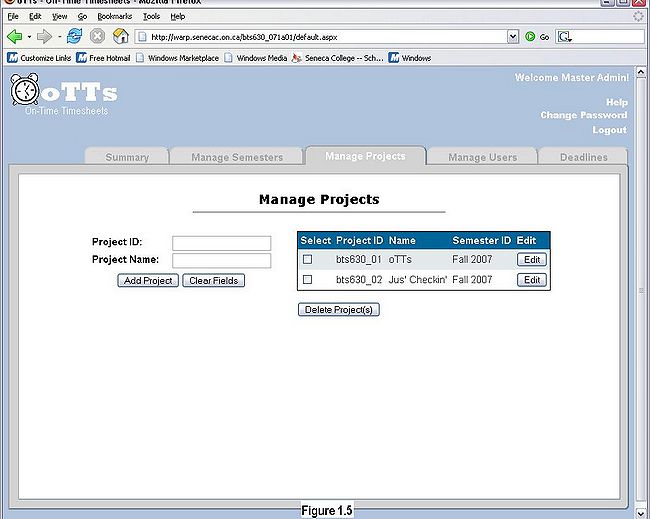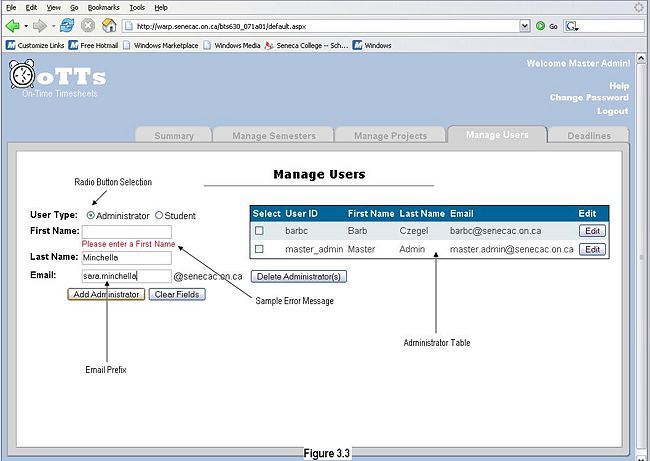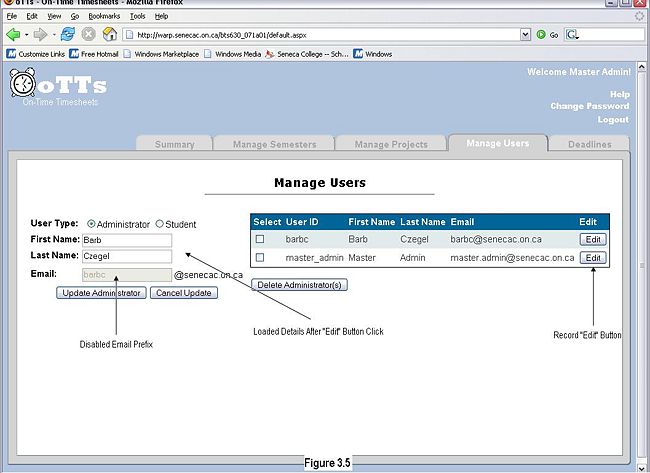Otts documentation
This Wiki/Project is a work in progress and is subject to change.
INTRODUCTION
Synopsis
oTTs, On-Time Timesheets, is an online system that allows Professors and Students to work collaboratively on System Design Projects. Seneca College's Computer Studies Department emphasizes strong team building skills, and achieves this through team projects. In the past, student and team progress have been monitored and maintained using conventional word processing documents. These conventional methods have proven to be difficult to synchronize between group members, and tended to lack substantial effort from those who were required to use them. oTTs creates an online environment where professors and students can work together to create and maintain personal timesheets and group project files. By allowing easy maintenance of projects and students for the professor, and simple manipulation functionality of timesheets and project files for students, oTTs takes the large task of project maintenance, and makes it simple for all of those involved.
Disclaimers
This project site and wikipedia are a student project only. Any opinions, statements or claims expressed here are those of the creators and are not necessarily those of Seneca College. Seneca College's Information Technology Acceptable Use Policy (ITAUP) can be found here.
INSTALLATION
System Requirements
In order to host oTTs, the system requirements are as follows:
- Internet Information Service (IIS)
- Web server such as warp.senecac.on.ca or hermes.senecac.on.ca
- Microsoft SQL Server
- ASP
- Compatible Browser (see Section 2.2 Browser Compatibility)
Browser Compatibility
oTTs strives to achieve a uniform appearance across all browsers and has been tested extensively on Firefox 2.0 and Internet Explorer 7. Either browser must have javascript enabled for full and proper functionality to work.
For the best performace, it is suggested that FireFox 2.0 is used, and the system be viewed in full screen mode.
Getting Started
Before you Begin
Make sure you have installed and met all system requirements listed in Section 2.1 System Requirements (link..?). This document will describe how to install oTTs assuming these requirements have been met.
Database Step Up
- Open SQL Query Analyzer, and connect to the warp server (http://warp.senecac.on.ca), using SQL Authentication.
- Enter your user ID and password, and click Connect
(INSERT SCREEN SHOT) - Once you are authenticated, select File -> Open and navigate to the location where the script, otts_schema.sql is located.
- Validate the script by pressing CTRL + F5
- Once the validation is complete, run the script by pressing F5. The query should read 1 row(s) affected. The database is now setup.
(INSERT SCREEN SHOT)
Note: By default after the script has been executed, there will be a master adminstrator login in the database. It is recommended to use this login in order to create the initial adminstrator login before using the system. It is also highly recommended that the master administrator login be deleted upon initial login. Since the master adminsitrator login does not have a valid email, simply changing the password is not allowed.
Master Adminstrator Login Information
User ID: master_admin
Password: master_password
System Deployment
FUNCTIONALITY
Logging In
There are two types of accepted users that may log into oTTs, students and administrators. The two are distinguished by their email addresses, students have email addresses with domains of "learn.senecac.on.ca" and professors have email addresses with domains of "senecac.on.ca". User ID's for both login types are each respective email prefix, for example a user with the email address of johndoe@learn.senecac.on.ca, their user id would be johndoe. Each user's initial password wil be emailed to them upon creation of their account by the administrator, the default password may be changed at any time by using the "Change Password" function (see Section 3.1.2 for details).
Forgotten Passwords
At the main login screen, users will be autheticated, and directed to the appropriate screen. If a user has forgotten their password, it may be retrieved by clicking the Reset Password Link located above the login button, see Figure 2.1. The user must enter a valid email address associated with their account inorder to have their password reset and emailed to them, see Figure 2.2.
Change Password Function
Passwords may be changed by the user by clicking on the Change Password button on the default screen, see Figure 2.3. A floating pop-up box will be displayed, and the screen below will be disabled. The user can change their password, or cancel the action without any changes occuring.Valid Passwords
Passwords must be at least one character in length, and are case sensitive. A password may contain numbers, letters, and most special characters with the exception of single quotation marks.
Administrator
The role of the Administrator user is to create and maintain all users and their associated projects, as well as semester start/end dates, and project/individual deadlines. When an administrator logs in, the default tabs are Summary, Manage Semester, Manage Project, Manage Users and Deadlines, all of which are described in the following sections. The layout is shown in Figure 1.4.
Manage Projects
An administrator must create at least one project before creating any student accounts. Each project must have an unique project ID, and a project name assoicated with it. When a project is added it is marked active for the current semester. Only active projects are displayed in the display list, and when a project is deleted, all assoicated users, timesheets and tasks are deleted as well. Upon deletion the administrator is prompted with an confirmation box, confirming the delete. The layout of the Manage Project Screen can be seen in Figure 1.5.Manage Users
An adminstrator can add or edit two types of users, other administrators or students. The type of user being added or edited is determined by which radio button is selected, this radio button also determines which user table is displayed to the right. Each user is identified by a user ID, this user ID is automatically assigned by using the prefix of the user's email address. A valid email address must be entered, the prefix can only contain letters (a-zA-Z), number (0-9), and special chacters of (- _ or .). Administration email addresses are automatically assigned the the domain of "senecac.on.ca", and student email addresses are automatically assigned the domain of "learn.senecac.on.ca". Once all of the corresponding fields have been entered and validated, the user is emailed an auto-generated password, this password should be changed as soon as possible using the Change Password function (see Section 3.1.2). A description of how to add or edit each type of user is listed below.
Adding an Administrator User
To add an administrator, make sure the "Adminstrator" radio button is selected. You must enter a first and last name of the administrator, each may only be a maximum of fifty characters. An email address prefix must also be entered, currently on the Seneca College Web Mail, a valid professor email address should be formatted as "first_name.last_name". The email prefix may only be thirty-six characters long. Once all of the required fields have been entered, click the "Add Administrator" button, and the new administrator will be shown in the table to the right. If there are any validation errors, they will be shown below each of the fields. For reference, see Figure 1.7
Adding a Student User
To add a student, make sure the "Student" radio button is selected. You must enter a first and last name of the student, each may only be a maximum of fifty characters. An email address prefix must also be entered, the email prefix may only be twenty characters long. Each student must also be assoicated with a project, to do this select a project name from the Project Name drop down list (the project ID is assoicated within this drop down list). Once all of the required fields have been entered, click the "Add Student" button, and the new student will be shown in the table to the right. If there are any validation errors, they will be shown below each of the fields.
A group of students may be entered at one time by uploading a Comma Separated Value File (CSV), in the file upload section (see Figure 1.8).
The format of the file should be as follows: Last_Name, First_Name, Student_ID, Project_ID, making sure that each field is separated by a comma.
An example of a record in this file would look like the following:
Doe, John, JDoe, bts630_071g01
For reference, see Figure 1.8
Editing a User's Details
To edit a user's details, press the "Edit" button located to the far right of the user's record. This will load the user's details into the form to the left. The email prefix will be disabled, and you will only be able to edit the enabled fields (first name and last name for an administrator, and first name, last name, and project ID/name for a student). Once you have edited the details, you can submit the changes by clicking the "Update <User Type>" button.Note: If you would like to change the user's email address, you will have to delete the user, and re-add them. (For deleting instructions please see Section 3.2.2.4, and for adding instructions please see Section 3.2.2.1 or 3.2.2.2) For reference, see Figure 1.9.
Deleting a User
To delete a user, select the check box to the left of their record in the table. You may select more than one user at a time. Once you have selected all of the users you wish to delete, click the "Delete <User Type>" button. You will be promted with a confirmation box, if you wish to continue, please click "Ok", if you do not want to continue with the delete, please click "Cancel".Note: If you are deleting a student, you will also be deleting all associated timesheets and tasks for this student. For reference, see Figure 2.0.
Deadlines
The administrator can create any number of deadlines for the current semester.
Manage Semester
Summary
Student
Current Timesheet
Past Timesheets
Project File
The project file contains all the tasks that a group has completed or is going to complete. All tasks are broken in Summary Tasks that categorizes these tasks. For example, Create Tables might be one task in your Database category.
Time is broken into hours, and fractions if necessary. For example, 3.33 hours represents 3 hours and 20 minutes. Which you can get by calculating (time you spent in minutes)/60
Reminders
The calendar has coloured days for a quick analysis of future deadlines.
- Purple days represent deadlines that the entire team is responsible for
- Green days represent individual deadlines and timesheet deadlines
